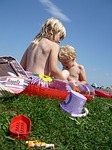Newborn Skin Condition
The newborn’s skin is rather delicate and is much more susceptible to normal rashes than an adult’ s. Up to half of all newborn’s between one and four days old develop from two to one hundred half-inch red spots which likewise disappear by themselves in a couple of days.
Not infrequently the baby’s skin peels around crease marks—particularly in the wrists, feet, and armpits.
During the first month after birth many infants temporarily develop pimples that look like acne on the forehead, cheeks, and chin (baby acne).

The face of the newborn has characteristics that are particularly attractive to the parent—the high forehead and the roundness of the face.
The eyes of all babies are greyish-blue at birth, which is not necessarily an indication of what colour they will later be.
Puffiness of the eyelids is not uncommon with newborns and spontaneously disappears in a day or two.
Excess tearing, redness, swelling, and even a watery or pussy discharge may follow administration of silver nitrate drops.
The newborn’s nose is characteristically flat and wide and gives no hint yet as to what its adult shape will be.
The nose as well as the mouth is commonly filled with amniotic fluid at birth.
As soon as this fluid has been cleared or sucked out, the baby breathes through its nose at a rate almost double that of an adult—thirty to forty breaths per minute.
The baby’s nostrils can often be seen to flare with increased breathing effort.
The baby’s mouth is well-defined and highly mobile. In the first few days the baby may develop blister like areas (sucking blisters) on the lips.
These are not unusual and disappear by themselves. The baby’s tongue is pro portionately shorter than that of an adult.
Parents Sometimes worry the baby is “tongue-tied, since the frenulum, the Connective membrane under the tongue, appears to attach so far forward.
Actually, this is normal the tongue grows rapidly and soon moves freely.
Because of the way the baby belly bulges , its troso is quite unlike of that of adult.The baby breathes abdominoly i.e. the belly fells rises and falls with each breath.
The baby’s umbilical cord begins to dry and turn leathery immediately after it is cut and tied.
This is due to the fact that the slight length of cord still attached to the baby is no longer getting any blood through the arteries, which have contracted.
Actually the remnant of the cord dries up and falls off with the help of bacteria that digest the dead skin cells.
A slight bulge around the umbilical cord. It is not uncommon and is not dangerous. It generally disappears by the end of first year.
